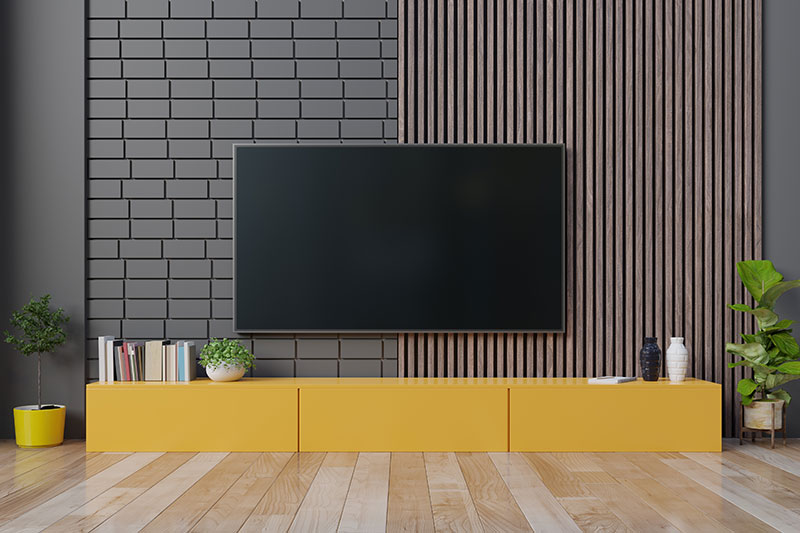Advertisement
Home entertainment is a must. It’s now a requirement for a comfortable and cozy home. Of course, entertainment choices vary from every household. It spans from karaoke, theater, gaming room, playroom, and never forget – the television. These options are based on personal preferences. However, television is one home entertainment device that never gets old, perhaps because it’s one of the first products of technology that became revolutionary. Models are constantly upgraded, but the concept remains all the same.
Nonetheless, the television stays as a centerpiece in the living room where families gather and spend quality time together. This means that aside from its practical use, it also has decorative benefits which enhance the interior design of the house. For the strategic location, style, and aesthetic factor, there is a need for an appropriate low-line TV unit. RJ Living’s range of lowline TV and entertainment unit boasts a variety of themes, designs, and materials perfect for the television glow-up! Here are some plans one should know.
Themes
Contemporary: This style is bold and daring. It emphasizes designs that would never make it in the past. The new touch exudes a very modern architecture and style.
Traditional: Unlike any other style, classic is as timeless as ever. The designs are rich in wood tones; the cabinetry of a lowline TV unit is filled with exemplary woodwork patterns and natural appearance.
Modern: This style of lowline TV unit is based on cutting edges. It mainly emphasizes function and form in an equal measure. Moreover, contemporary style is an expert in producing unique and progressive looks.
Rustic: Most often than not, rustic-styled furniture is made to appear old-fashioned and woodsy with an earthy vibe. It also utilizes a timeworn appearance.
Industrial: This style combines the visuals of wood and steel. The lowline TV stands offer an elegant mixture of gunmetal and dark shades, which perfectly complements tone rooms naturally.
Designs

Open Shelving: As it climbs its way to popularity, this design is ideal for space conservationists to create more room for visuals. Most often than not, open shelving comes with the mainframe that holds many shelves. The structure provides the mounting bracket where the television will be securely attached.
Console: This particular design incorporates the art of shelving and space conservation while keeping a singular, holistic design. Most television stand which uses this design have closed shelving and a rectangular structure.
Audio Towers: A magnificent design with audio towers boasts its advantages in terms of functionality and presentation. A TV with excellent audio? That’s top-notch home entertainment right there. Structure shelves on either side of the center stand can be used for decorations, books, and of course, audio supplements – you name it.
Hutch: This unique design pertains to the cabinetry stacked horizontally on the counter space. The TV stand prioritizes the room for television with an attached flanking cabinetry.
Cabinet: This design is applicable in two ways: console-style with the cabinetry underneath a concave surface or a standard style with drawers below an enclosed surface with the advantage of hiding the screen when not in use.
Swivel: Another exciting TV design is called Swivel, where the mechanism is set for the TV stand to rotate. Hate to change from one comfortable position to another? Well, let the TV stand do one’s bidding and angle it beforehand for better visibility! Furthermore, this design is ideal for TVs without a rotating base.
Floating: The best place for the TV in the living room is undoubtedly nowhere except the wall. The floating design is technically a wall-mounted unit, hence the name. It offers an entirely open floor with an unobtrusive look. The method also includes shelving and cord concealment. The TVs can either be placed on top or mounted above the floating stand.
Entertainment Center: In contrast to the other previous designs, the entertainment center tends to make a statement. Its massive presence, artistic style, and detailed construction set the mood of the living room. These designs are more significant than the standard TV stands and often contain shelving with closed cabinetry for books, arts, and any form of a media collection.
Material
Wood: As this stands as the most traditional material for furniture, it’s also the most common choice for TV stand construction. The wood’s earthy style, color, and utility are its most precious characteristics. As a result, the most luxurious models appear in wood with intricate details despite metal and glass gaining popularity – they’re still secondary to wood.
Metal: The benefits of metal lie in its strength, durability, lightweight, and profile. The TV stands using metal can be shaped into unique patterns and cuts, making it an excellent choice for contemporary and modern designs.
Glass: In contrast to solid wood and metal, glass is perfect for concealment as it maximizes visibility with a touch of refined yet bold appearance. The glass opens a more expansive visual space that discreetly reveals electronics. Moreover, the material is excellent for homeowners who value clutter-free space.
Conclusion:
Entertainment comes in different shapes and forms, but nothing beats the television when it’s for the home. For maximum comfort and enjoyment, enhance the TV stand of your lowline TV unit by applying different styles and designs made from the most appropriate materials that transform the vibe of the entire house. Also, don’t let the TV stand be the only new feature! Check the latest television reviews and upgrade to a new TV. Find the perfect stand for the ideal TV and finally – enjoy the perfect view.

